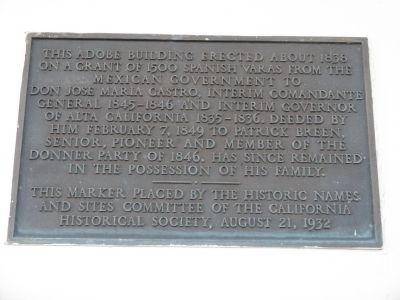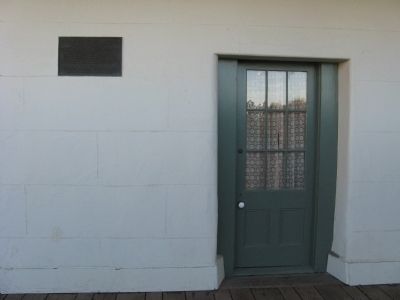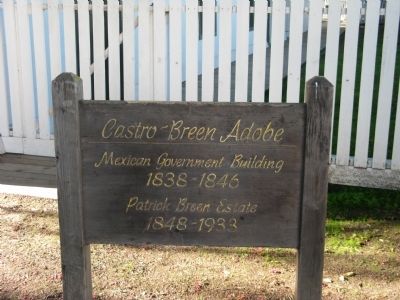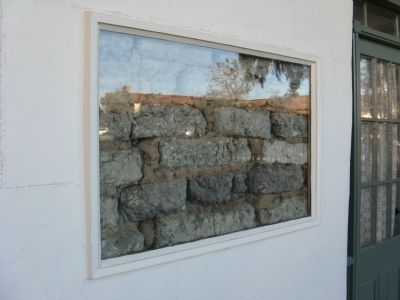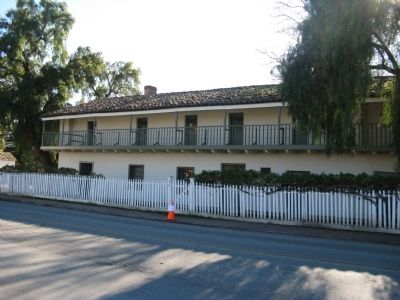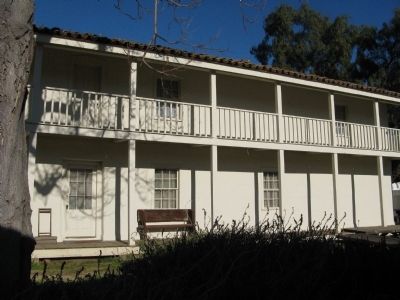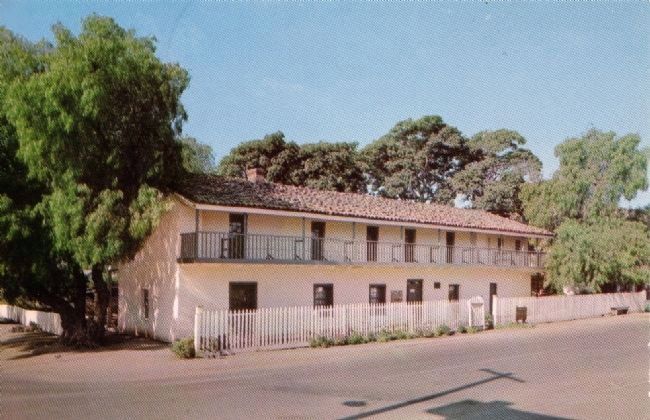San Juan Bautista in San Benito County, California — The American West (Pacific Coastal)
Castro - Breen Adobe
This adobe building erected about 1838 on a grant of 1500 Spanish varas from the Mexican Government to Don Jose Maria Castro, interim Comandante General 1845-1846 and interim Governor of Alta California 1835-1836. Deeded by him February 7, 1849 to Patrick Breen, Senior, Pioneer and member of the Donner Party of 1846. Has since remained in the possession of his family.
Erected 1932 by The Historic Names and Sites Committee of the California Historical Society, August 21, 1932. (Marker Number 179.)
Topics and series. This historical marker is listed in these topic lists: Architecture • Government & Politics • Industry & Commerce • Settlements & Settlers. In addition, it is included in the California Historical Landmarks series list. A significant historical month for this entry is February 1825.
Location. 36° 50.684′ N, 121° 32.141′ W. Marker is in San Juan Bautista, California, in San Benito County. Marker can be reached from the intersection of Second Street and Washington Street. Marker is mounted on the building. The building is located at the San Juan Bautista State Historic Park. Touch for map. Marker is in this post office area: San Juan Bautista CA 95045, United States of America. Touch for directions.
Other nearby markers. At least 8 other markers are within walking distance of this marker. Castro/Breen Adobe and Plaza Hotel (within shouting distance of this marker); Town Jail (within shouting distance of this marker); San Juan Bautista Plaza Historic District (within shouting distance of this marker); Veterans of the World War (within shouting distance of this marker); Progress Becomes History (within shouting distance of this marker); Vicky’s Cottage (about 300 feet away, measured in a direct line); The Amah Mutsun Garden (about 300 feet away); El Camino Real (about 300 feet away). Touch for a list and map of all markers in San Juan Bautista.
Also see . . . San Juan Bautista History. City website homepage:
After 1834 the town of San Juan, close beside the old mission, became known temporarily as San Juan de Castro. Jose Tiburcio Castro became the civil or secular administrator of the mission and, acting in accordance with the mission secularization decree issed that year, he divided up the mission property and auctioned it off to friends, neighbors and relatives. (Submitted on January 16, 2009.)
Additional commentary.
1. The Castro House
This building was designated as California Registered Historical Landmark No.179 on March 6, 1935.
Statement of Significance:
In the 1840s the Castro House was built to house General José Castro's administrative office and his secretary. In 1848 Castro sold the house to Patrick Breen, survivor of the ill-fated Donner party of 1846, and the Breen family lived here for many years.
This property was also listed on the National Register of Historic Places on 4/15/70.
— Submitted January 16, 2009, by Syd Whittle of Mesa, Arizona.
2. Castro-Breen Adobe
As members of the ill-fated Donner Party, Patrick and Margaret Breen and their seven children had been stranded in the Sierra Nevada without supplies for 111 days during the snowstorms of 1846. It is said that they arrived penniless in San Juan and were given free shelter in the Mission. Early in 1848, when word came that gold had been discovered in the Sierra foothills, one of the Breen children, 16-year old John, set out for the goldfields and returned with about $10,000 in gold dust.
In December 1848 the Breens purchased the Castro adobe and later 400 acres of land in the San Juan Valley. Until 1933, when it became part of the State Historic Park, the old adobe was occupied by succeeding generations of the Breen family and their employees.
Source:
San Juan Historical Park Brochure
— Submitted January 16, 2009, by Syd Whittle of Mesa, Arizona.
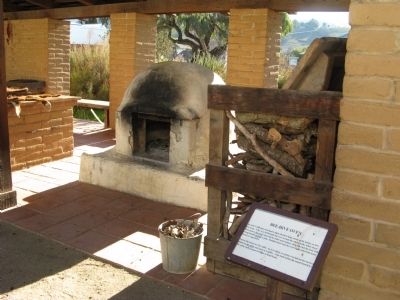
Photographed By Syd Whittle, January 11, 2009
7. Bee-Hive Oven on the Grounds of the Castro Adobe
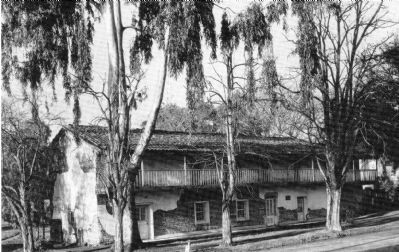
Photographed By Plaza History Assoc. San Juan Bautista SHP, 1998
8. Castro - Breen Adobe, c1933
Description on postcard:
This adobe brick building was built around 1836, the the Mexican government for use as military offices. In 1848, Patrick Breen and his family purchased it for their residence.
Photo Credit: California State Parks
This adobe brick building was built around 1836, the the Mexican government for use as military offices. In 1848, Patrick Breen and his family purchased it for their residence.
Photo Credit: California State Parks
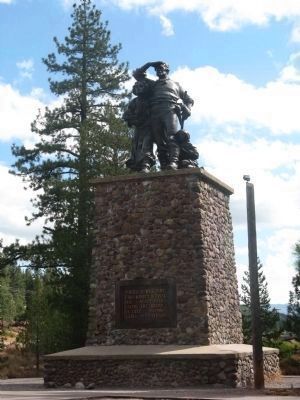
Photographed By Syd Whittle, September 20, 2008
10. The Donner Monument
Patrick Breen and his family survived the heavy snows of 1846 for 111 days at this site.
Click for more information.
Click for more information.
Credits. This page was last revised on December 27, 2021. It was originally submitted on January 16, 2009, by Syd Whittle of Mesa, Arizona. This page has been viewed 2,657 times since then and 47 times this year. Photos: 1, 2, 3, 4, 5, 6, 7. submitted on January 16, 2009, by Syd Whittle of Mesa, Arizona. 8. submitted on January 18, 2009, by Syd Whittle of Mesa, Arizona. 9. submitted on January 16, 2009, by Syd Whittle of Mesa, Arizona. 10. submitted on January 23, 2009, by Syd Whittle of Mesa, Arizona.
